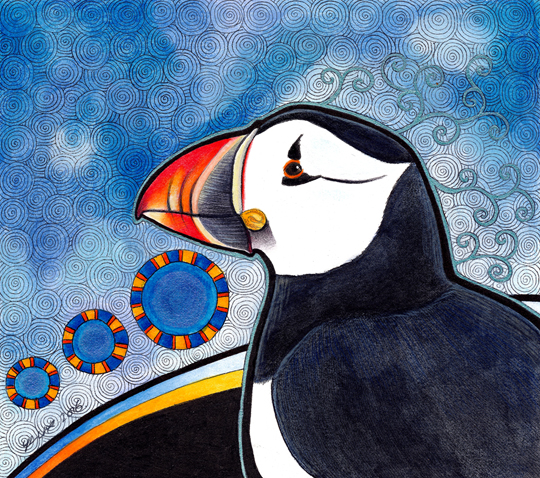Atlantic Puffin – The Night Sea Journey 
Keywords:
The night sea journey. Sea mysteries. There’s no place like home. Living two lives. Ambivert. Community and solitude. Charisma. Sweetness and curiosity. Having an open mind. Gather your wisdom and bring it back. Rigorous and attentive self-care is necessary on a regular basis. Gracefulness, clumsiness. Humour. Maintain your living spaces. At times caring more about places than people.
Description:
The Atlantic puffin (Fratercula arctica), known as the common puffin, as well as sea parrot and ‘clown of the sea,’ is a seabird and the only puffin native to the Atlantic Ocean. It has a large geographical range, but its population has been rapidly declining. The Atlantic puffin has bold patterning that is instantly recognisable. They spend part of their lives (autumn and winter) on the open ocean, before returning at late spring to their clifftop colonies in order to breed in places like Norway, Canada, Iceland (particularly the Westman Islands) and the Faroe Islands, with smaller colonies found elsewhere.
It dives underwater to hunt, using its wings to swim, feeding primarily on small fish. At sea, they can be hunted by seals and large fish. They are powerful swimmers and keep their feathers in good swimming condition by spending a lot of time each day preening and spreading oil from their preen gland. They keep themselves turned into the wind, even when asleep. They are clumsy when landing after flying, sometimes bellyflopping into the ocean or on land. Atlantic puffins prefer island colonies with no land predators but are still hunted by gulls and skuas. They will also have the fish they’ve caught stolen from them. They live a long time.
The puffin’s beak is colourfully notable and is very powerful. They lay a single white egg, with both parents raising the offspring. Chicks grow rapidly, largely eating whole fish. When it fledges, it makes its way at night to cold seas, swimming away, and does not return to land for years. They are usually silent at sea, though it may purr in flight. They are generally quieter than many other seabirds. They can range huge distances, with one tracked bird found to have covered 7,700 kilometres in eight months. For some of the year they live a solitary existence, which becomes hugely social during breeding season. Puffins do not like to land in places where they cannot see other puffins, at this time of year. Atlantic puffins have dominance displays on their breeding grounds, and have a hierarchy of more submissive and more dominant birds. Atlantic puffins spend much time on land focusing on preening, social behaviours, and nest upkeep.
The Atlantic puffin is the official bird of Newfoundland and Labrador. It is recognisable in logos such as the Puffin Books for children. Around humans, Atlantic puffins can be curious, playful and inquisitive and are appealing to tourists. Atlantic puffins are dropping precipitously in number and are now considered Vulnerable (as at the time of this writing, in 2021). It is theorised that Atlantic puffins are breeding less due to overfishing and lack of food, though they are also hunted. They can be profoundly affected by oil spills, as well as heavy metals in the ocean, and climate change. There are many Atlantic puffin conservation projects all around the Northern Hemisphere, they are beloved, cheerful, charismatic bird, and have garnered much support.
Was this helpful?
0 / 0